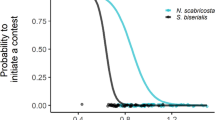Abstract
In shell fights of the hermit crab,Pagurus geminus, frequently it is observed that large crabs (attackers) grasp the thoracic appendage of small crabs (defenders) with the major cheliped and pull the smaller crabs out of their shells. If this is a standard occurrence and result, then the interaction should not be called a “negotiation” (Hazlett 1978). The role of cheliped use by the attckers in the eviction of defenders was therefore studied using crabs with tubes on their chelipeds, and the effect of shell rapping, which is thought to be necessary for eviction, was studied using crabs without shells. The experimental crabs evicted the defenders but fighting was significantly prolonged. Therefore, the negotiation model cannot be rejected. Specific aspects of shell fights in hermit crabs are discussed.
Similar content being viewed by others
References
Allee, W.C. & M. B. Douglis 1945 A dominance order in the hermit crab,Pagurus longicarpus Say.Ecology 26: 411–412.
Dowds, B. M. & R. W. Elwood 1985 Shell wars II: the influence of relative size on decisions made during hermit crab shell fights.Anim. Behav. 33: 649–656.
Elwood, R. W. & C. W. Glass 1981 Negotiation or aggression during shell fights of the hermit crabPagurus bernhardus?Anim. Behav. 29: 1239–1244.
Elwood, R. W., A. McClean & L. Webb 1979 The development of shell preferences by the hermit crabPaurus bernhardus.Anim. Behav. 27: 940–946.
Hazlett, B. A. 1966 Social behavior of the Paguridae and Diogenidae of Curacao.Stud. Fauna Curacao 23: 1–143.
Hazlett, B. A. 1970 Tactile stimuli in the social behavior ofPagururs bernhardus (Decapoda, Paguridae).Behaviour 36: 20–48.
Hazlett, B. A. 1978 Shell exchanges in hermit crabs: Aggression, Negotiation, or both?Anim. Behav. 26: 1278–1279.
Hazlett, B. A. 1987 Information transfer during shell exchange in the hermit crabClibanarius antillensis.Anim. Behav. 35: 218–226.
Imafuku, M. 1983 New shell acquisition in the hermit crab,Pagurus geminus.J. Ethol. 1: 91–100.
Imafuku, M. 1984 Quality of shells occupied by the hermit crabPagurus geminus: How many hermit crabs are satisfied with their shells?J. Ethol. 2: 31–36.
Imafuku, M. 1985 Shell exchange of the hermit crabPagurus geminus.Nankiseibutu 27: 70–74. (In Japanese with English abstract).
Kinoshita, H. & A. Okajima 1968 Analysis of shell-seaching behavior of the land hermit-crab,Coenobita rugosus H. Milne Edwards.J. Fac. Sci. Tokyo 2: 293–358.
Orians, G. H. & C. E. King 1964 Shell selection and invasion rates of some Pacific hermit crabs.Pac. Sci. 18: 297–306.
Reese, E. S. 1962 Submissive posture as an adaptation to aggressive behavior in hermit crabs.Z. Tierpsychol. 19: 645–651.
Reese, E. S. 1963 The behavioral mechanisms underlying shell selection by hermit crabs.Behaviour 21: 77–126.
Reese, E. S. 1983 Evolution, neuroethology, and behavioral adaptations of crustacean appendages. In: S. Rebach & D. Dunham (eds.)The behavior of higher crustacea. pp. 57–81. John Wiley & Sons, New York.
Author information
Authors and Affiliations
About this article
Cite this article
Imafuku, M. Shell fights in the hermit crabPagurus geminus: Effect of cheliped use and shell rapping. J. Ethol. 7, 35–39 (1989). https://doi.org/10.1007/BF02350580
Received:
Accepted:
Issue Date:
DOI: https://doi.org/10.1007/BF02350580




